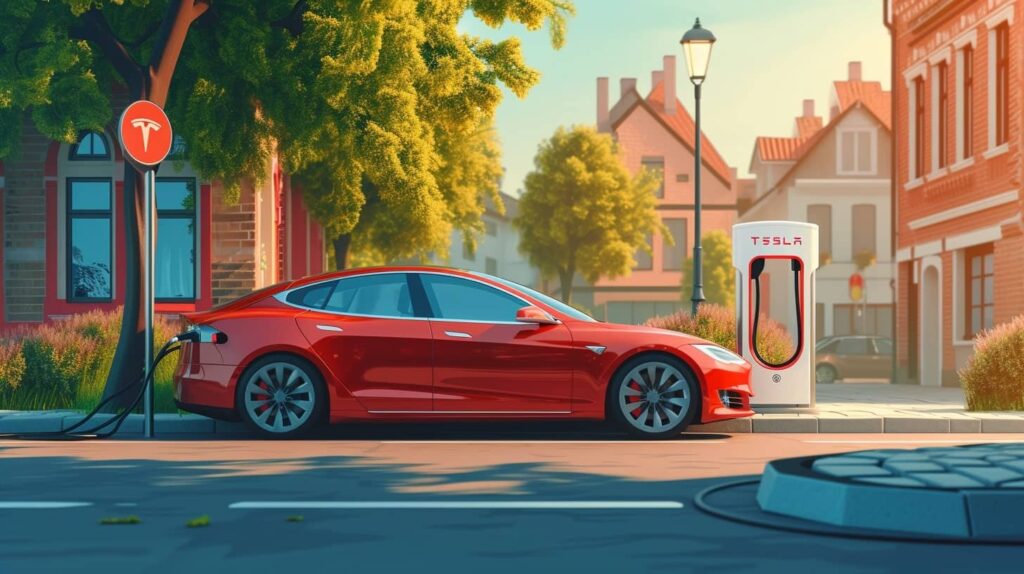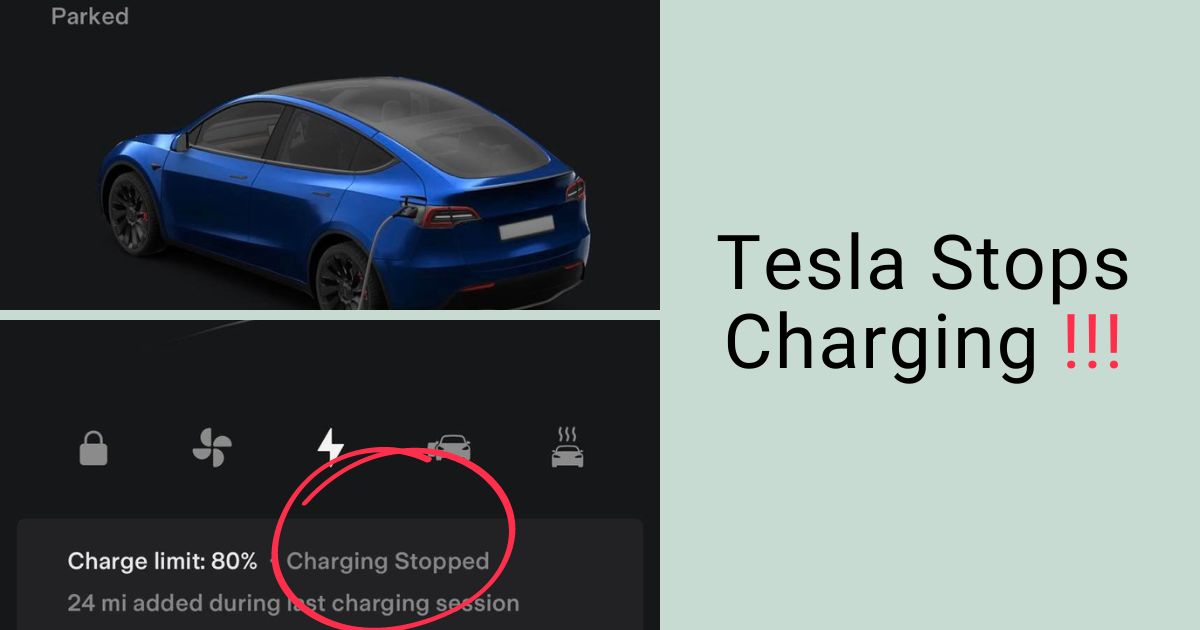To prevent overcharging and maintain safety, Tesla adjusts charging speed. But as with any technology, it has many complications. Sometimes, it stops charging altogether after a while.
So, What are the reasons why Tesla stops charging after a few minutes? There are some common reasons behind this issue are:
- Overheating
- Outdated Software for the Charging Process
- Problem with charging cables
- Dirty Charging Port
- Charging Station Compatibility
- Lack of electrical supply
- Melting of Fuse Box
- Burning out chips, etc.
The article attempts to clarify the traits, common problems, and potential solutions. Thus, if you want to make sure you don’t miss any important Tesla Charging information, keep reading this page.
The Reason Why Tesla Stops Charging After a Few Minutes

There could be various reasons why a Tesla stops charging after a few minutes. Let’s see some common factors to consider:
1. Problem With the Charging Cables
The connectors and wires on your Tesla are strong, but they can get worn down over time if they are exposed to water or used a lot. This could lead to problems, like charging taking longer or being hard to do.
Explore our guide on Tesla Mobile Connector vs Wall Connector for comprehensive tips and insights into preserving the integrity of your charging infrastructure.
2. Outdated Software or Glitches in the Software of Tesla
Due to outdated software, Tesla’s charging software may be generating communication issues between your Tesla and external charging solutions.
Furthermore, specific versions of the Tesla wall connector software have been linked to instances of the vehicle charging for no apparent reason.
Also, the presence of a programming malfunction in the car might lead to complications in the charging process, potentially resulting in the cessation of charging functionality.
3. Matching Charging Station Compatibility
A few charging points made by other companies might not work well with Tesla’s system. This could make it harder to charge. Also, your Tesla might stop charging after a short time if you use a public charging station that isn’t being kept up or is having technical problems.
4. Response of Overheating
Tesla’s advanced technology effectively regulates the temperature of the battery throughout the charging process, preventing excessive heat buildup.
During the charging process, the battery charger has the potential to cease operation if the battery reaches an excessively high temperature. This phenomenon may occur in extreme temperature conditions, either excessively hot or cold, or in the event of malfunctioning battery temperature sensors.
5. Dirty Charging Port
Charging a Tesla may provide challenges if there are issues with the charging infrastructure at the designated charging location. The charger may be impeded from charging effectively due to the presence of dust, grime, corrosion, an obstruction in the port, or any other form of damage.
6. Lack of Electrical Supply
The charging process of your Tesla vehicle may be interrupted in the event of excessive or insufficient power supply from your home or the electrical supply station.
Potential causes include voltage fluctuations, power surges, and other electrical anomalies.
7. Incomplete Plug Connection
When the plug is partially connected, there may be fluctuations in the charging process. Thus, the charging process may experience interruptions.
8. Melting of Fuse Box
A fuse box is a safety measure. When the charging current surpasses the system’s capacity, the enclosed metal wire or strip will undergo a phase change and melt.
In this manner, the continuity of the existing supply may be disrupted, posing a possible risk of harm to other essential constituents. Therefore, Tesla ceased the charging process.
9. Burning Out of Chips
Also, your Tesla has some small chips inside it. One of them is called an eMMC flash storage chip. This chip helps the car take in power. But this can cause trouble sometimes and burnout because it does too much work.
That throws off the car, which could stop charging on its own or not start charging at all.
10. Schedule Charging Time
If the charging time is scheduled for some period, it will stop charging after the scheduled time is over.
Troubleshooting Guide for Charging Problems and Solutions
Now, let’s look at these different ways to troubleshoot the problems and find out how to resolve them.
Checking Charging Cable
Check whether your charging point and cord are damaged or not. If you find the problem, you have to change the original Tesla cords or connectors and make sure everything works right again.
You must not use fake or third-party charging cords as they may not meet Tesla’s standards. Moreover, they can damage your car’s charge system.
Check this video on how to change the charging port.
Resetting the System of Car
Sometimes, the charging problem can be resolved by resetting the car system. Here, I am sharing steps for resetting the car,
- Step 1: Shift your car into parking mode.
- Step 2: Just hold down both the steering and scroll wheels for a short time until your car’s display goes black.
- Step 3: This will allow the system to resume while you wait for your Tesla logo to appear on the screen before releasing the scroll wheels.
If your problem persists, follow this process below
- You must make sure your car is in “Park” mode after parking.
- Press “Controls” then “Safety & Security”.
- Lastly, press the “Power Off” in the middle of the screen.
- You should wait for two minutes after turning off the car and the screen before touching anything.
- There is to be no opening of doors, pressing of buttons, or touching of screens during this period.
- After letting the automobile rest for two minutes, you should either step on the brake pedal or open the door to reawaken it.
Here is a video to see how to reset your Tesla.
Checking the Battery Temperature
You need to take care of the temperature of the battery.
- You should allow the Tesla battery to cool down before charging in extremely hot or cold weather.
- You should use the Tesla app to warm up or cool down the battery.
- Examine the battery temperature sensors for cleanliness.
- You must contact Tesla customer service if you believe there is a problem.
Keep Update Your Software
If your Tesla stops charging, it could be due to a software malfunction and update. You must check for and install any available software upgrades on your vehicle. In this way, you can resolve the issue and ensure that your Tesla’s charging system functions properly.
Extra Tesla Wall Charger
You, as a Tesla owner, can enjoy a wall charger fixed to your home for charging. However, it’s crucial to have a skilled electrician who can install and connect it to the home’s power and adjust the charger’s power to the home’s electrical supply.
Remove Third-Party Apps
Third-party apps, such as ChargePoint App, Optiwatt, etc., are reported for troubleshooting charging issues.
You may find wonderful features like a charging limit, plan charging to happen at off-peak times, and even start or stop charging from afar. But a lot of Tesla owners have said that these apps stopped their cars from charging. As those apps may contain software bugs. Hence, you need to get rid of them.
Clean the Charging Port
However, dust, dirt, and corrosion decrease efficiency. So, you need a clean charging port for better charging.
Change the Wall Connector Firmware
The software version of your Tesla home charger may be the cause of charging problems. Therefore, Tesla suggests you downgrade to a previous version, such as “22.41.2,” as a workaround.
However, to fix the problem, you can install stable firmware. Also, updating a recent firmware has also resolved the issue. You should keep an eye on updates, install if available, or temporarily revert to the previous version.
Motoring Charging Breaker
If your Tesla is having charging problems in your home, check the circuit breaker first. If too much electricity flows, the circuit breaker, which is responsible for stopping charging, may break.
In this case, you have to follow certain tips, they are.
- You should find the switch with the breakers.
- Then, you have to find the breaker that is linked to the charging port.
- If it’s tripped, turn it off and then back on to try again.
But if the circuit breaker keeps going, it means there is a bigger problem with the electricity. In these situations, it’s important to get help from a professional electrician to fully inspect and fix the problem.
FAQs
Here, I am answering a few of your commonly asked questions regarding Tesla charging issues. Check them out.
Tesla vehicles are equipped with temperature-management technologies to keep the battery safe in severe temperatures. That’s why it stops charging in harsh weather.
Yes, there are differences. Superchargers offer faster charging rates, while home charging is slower. Additionally, charging at superchargers costs money, while the home charging bill is included with the electrical bill.
You can schedule charging time using your Tesla software. This feature allows you to charge during off-peak hours when electricity rates typically lower and demand is reduced.
Yes, Tesla allows you to monitor and control charging remotely. You can view the charging status, set the charging limit, and receive notifications. Thus, overheating can be controlled.
Conclusion
I have discussed a few reports on why Tesla stops charging after a few minutes and their solutions to this problem in this article. You can find and fix the problem if you understand the different causes and try the solutions that have been offered.
Besides, you must make sure the charging cords work with the device, check the temperature of the battery, update the software, and make sure the power is stable.

I am an experienced guide in electric mobility, offering clear and expert guidance for those venturing into the world of electric vehicles.
Through collaborations, research, and hands-on experience, I navigate readers through the evolving landscape of smart automobile technologies and the significance of renewables.

